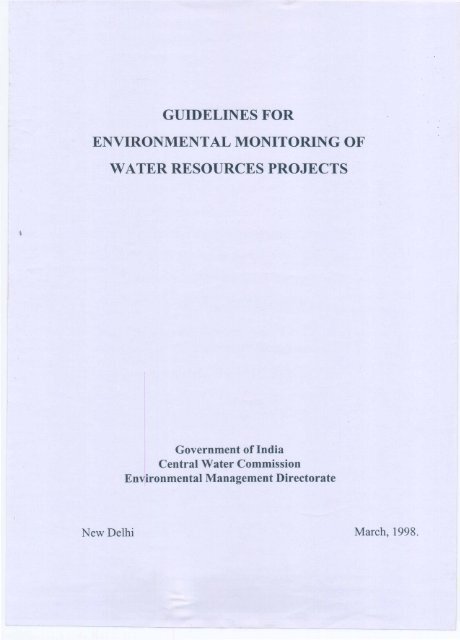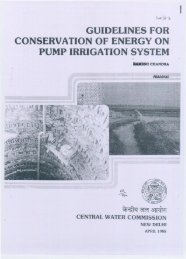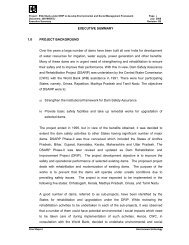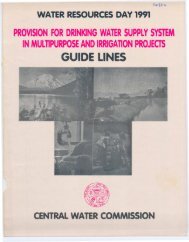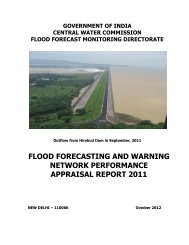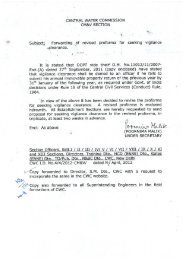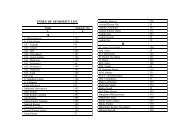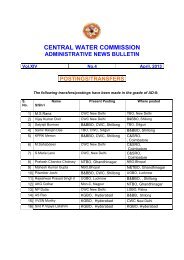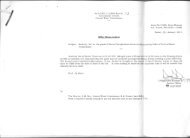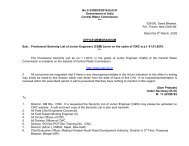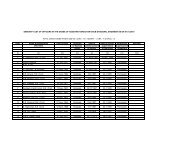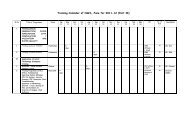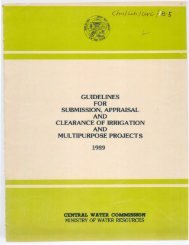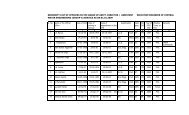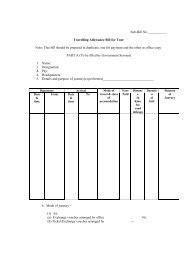guidelines for environmental monitoring of water resources projects
guidelines for environmental monitoring of water resources projects
guidelines for environmental monitoring of water resources projects
You also want an ePaper? Increase the reach of your titles
YUMPU automatically turns print PDFs into web optimized ePapers that Google loves.
GUIDELINES FOR<br />
ENVIRONMENTAL MONITORING OF<br />
WATER RESOURCES PROJECTS<br />
Government <strong>of</strong> India<br />
Central Water Commission<br />
Environmental Management Directorate<br />
March, 1998.
First edition<br />
Second edition<br />
January, 1996<br />
March, 1998
Environmental clearance to various <strong>water</strong> <strong>resources</strong> <strong>projects</strong> is accorded by the Ministry<br />
<strong>of</strong> Environment and Forests. While doing so, certain <strong>environmental</strong> safeguards are stipulated<br />
which are required to be implemented alongwith the construction <strong>of</strong> the project. In order to<br />
ensure the implementation <strong>of</strong> these safeguards, an Environmental Monitoring Committee was<br />
constituted by the Ministry <strong>of</strong> Water Resources during February, 1990. It is headed by the<br />
Member (WP&P), with Director (EM) as the Member Secretary. The Committee is assisted by<br />
various State Level Environmental Monitoling Committees and Project Level Environmental<br />
Management Committees.<br />
The Central Water Commission was earlier represented on the Project Level<br />
Environment,al Management Committees by the Director (EM). However, with the<br />
establishment <strong>of</strong> various regional units <strong>of</strong> CWC, it has been decided that the concerned Directors<br />
(Appraisal/Monitoring and Appraisal) would be members <strong>of</strong> the Project Level EMCs. In this<br />
capacity, they have to play' a key role in the <strong>environmental</strong> <strong>monitoring</strong> <strong>of</strong> <strong>water</strong> <strong>resources</strong><br />
<strong>projects</strong>.<br />
In order that the <strong>environmental</strong> <strong>monitoring</strong> is effective and uni<strong>for</strong>m, some sort <strong>of</strong><br />
<strong>guidelines</strong> are necessary. No <strong>guidelines</strong> were, however, available on the subject. The present<br />
publication, origi~ally brought out in 1996, was a step in this direction. It has been found to be<br />
very useful <strong>for</strong> the regional <strong>of</strong>ficers <strong>of</strong>~CWC associated with the work <strong>of</strong> <strong>environmental</strong><br />
<strong>monitoring</strong>. Moreover, <strong>environmental</strong> management being an emerging field, the <strong>guidelines</strong> have<br />
also been found· useful by the project authorities who are responsible <strong>for</strong> implementing the<br />
<strong>environmental</strong> safeguards. This revised edition has been brought out to meet the continued<br />
demand <strong>for</strong> the publication.<br />
I would like to convey my appreciation to Shri R.K. Khanna, Director (Environmental<br />
Management) <strong>for</strong> putting in considerable ef<strong>for</strong>t in the compilation and updating <strong>of</strong> these<br />
<strong>guidelines</strong>.<br />
(P.C. MATHUR)<br />
CHIEF ENGINEER (EMO)
Thedevelopment <strong>of</strong> <strong>water</strong> <strong>resources</strong> has always been given due recognition<br />
and importance in our country. Indian history contains description <strong>of</strong> numerous<br />
irrigation and <strong>water</strong> works constructed from time to time in order to fulfil the<br />
agricultural, municipal, and other needs <strong>of</strong> the people.<br />
Water <strong>resources</strong> development in the country got a boost during the postindependence<br />
period. ThePlan period, commencing with the first Five Year Plan in<br />
1950-51, ushered in a new era in the development <strong>of</strong> <strong>water</strong> <strong>resources</strong> in India and<br />
greatly contributed to the green revolution.<br />
With the all-round development <strong>of</strong> <strong>water</strong> <strong>resources</strong>, their <strong>environmental</strong><br />
aspects also came to be noticed. It also led to the realisation. thqt the <strong>water</strong><br />
<strong>resources</strong> development should be planned in such a manner that it leads to<br />
enhancement in the qualify <strong>of</strong> environment rather than its degradation.<br />
With the above objectives in view, the Ministry <strong>of</strong> Environment and Forest has<br />
been stipulating certain <strong>environmental</strong> safeguards while clearing the <strong>projects</strong>.<br />
Thesesafeguards are to be implemented alongwith the construction <strong>of</strong> the <strong>projects</strong>.<br />
In order to assist the concerned authorities in <strong>monitoring</strong> the implementation <strong>of</strong><br />
these safeguards, <strong>guidelines</strong> were brought out by the Central Water Commission<br />
during 1996. These <strong>guidelines</strong> proved to be extremely useful not only to the field<br />
units <strong>of</strong> CWC but to the State Governments and other concerned agencies as well.<br />
Thepresent edition has been updated regarding the <strong>environmental</strong> acts, number <strong>of</strong><br />
<strong>projects</strong> monitored etc. Some general in<strong>for</strong>mation regarding the <strong>water</strong> <strong>resources</strong><br />
development in India, its legal framework, national policies etc. has also been<br />
aOded.<br />
Shri P.C. Mathur, Chief Engineer and Shri R.K. Khanna, Director <strong>of</strong> the<br />
Environmental Management Organisation, deserve appreciation <strong>for</strong> their ef<strong>for</strong>ts in<br />
bringing out this revised edition.<br />
~~<br />
(Z.~<br />
Chairman<br />
Central Water Commission
Environmental Monitoring Committee/<br />
Environmental Management Committee
Representation <strong>of</strong> ewe by its Regional Officers in the<br />
Project Level EMC
List <strong>of</strong> the Projects s'elected by Envirornnental<br />
Monitoring Committee <strong>for</strong> <strong>monitoring</strong><br />
List <strong>of</strong> Projects selected <strong>for</strong> close<br />
<strong>monitoring</strong> by EMC.<br />
Organisational structure <strong>of</strong> National Level<br />
Environmental Monitoring Committee.<br />
Organisational structure <strong>of</strong> State Level<br />
Envirornnental Monitoring Committee.<br />
Organisational structure' <strong>of</strong> Project Level<br />
Envirornnental Management Committee.<br />
Highlights <strong>of</strong> Draft National Policy <strong>for</strong><br />
Resettlement and Rehabilitation.<br />
Pro<strong>for</strong>ma <strong>for</strong> furnishing quarterly Progress Reports<br />
regarding implementation <strong>of</strong> elwirornnental safeguards.
GUIDELINES FOR ENVIRONMENTAL MONITORING OF<br />
WATER RESOURCES PROJECTS<br />
The annual renewable fresh <strong>water</strong> supply in India is about 1870 cubic<br />
kn. which is 4 percent <strong>of</strong> the world's total <strong>of</strong> around 47000 cubic~. The<br />
per capita annual availability <strong>of</strong> <strong>water</strong> in the country is about 2200 cubic<br />
metres which is much lower than the world average <strong>of</strong> about 8500 cubic metres.<br />
The corresponding figures <strong>for</strong> the <strong>for</strong>mer USSR, lJSA and China are 19500, 9900<br />
and 2420 cubic metres respectively.<br />
The principal consrunptive use has traditionally been <strong>for</strong> irrigation.<br />
India uses 83 percent <strong>of</strong> its <strong>water</strong> <strong>for</strong> agriculture as compared to the globai<br />
average <strong>of</strong> 69 percent.<br />
India has primarily been an agricultural country since the dawn <strong>of</strong><br />
civilisation and it still continues to be so. The total cultivable area in<br />
the country is 184 million hectares(mha) as against 186'mha in USA and 93 mha<br />
in China. Agriculture in the country has largely been dependent on rainfall.<br />
However, the uneven temporal and spatial distribution <strong>of</strong> rainfall renders it<br />
rather unreliable <strong>for</strong> agriculture. Irrigation developnent has, there<strong>for</strong>e,<br />
always been accorded high priority and 'attention by the Central and State<br />
Governments. The ancient holy book <strong>of</strong> Mahabharata (3000 Be) mentions about<br />
Rishi Narada, a great saint, visiting the court <strong>of</strong> King Yudhishtira (3150 Be)<br />
and enquiring about the welfare <strong>of</strong> the state. Among other questions, he<br />
asked, HAre the farmers sturdy and prosperous? Are there dams full <strong>of</strong> <strong>water</strong><br />
and big enough and distributed in various parts <strong>of</strong> the Kingdom and does<br />
agriculture not depend on rain only?H<br />
The artificial system <strong>of</strong> irrigation was devised in India from<br />
ancient times to meet the agricultural demands in case <strong>of</strong> failure <strong>of</strong> the<br />
monsoon rains. The country's history is full <strong>of</strong> description <strong>of</strong> various<br />
irrigation and <strong>water</strong>-works undertaken from time to time by various Kings to<br />
meet the agricultural and municipal demands.<br />
However, the <strong>water</strong> <strong>resources</strong> developnent <strong>for</strong> irrigation and other<br />
uses in the country got a boost during the post-independence (1947) period.<br />
The plan period, commencing with the First Five Year Plan in 1950-51, ushered<br />
in a new era in the development <strong>of</strong> <strong>water</strong> <strong>resources</strong> in India. The irrigation<br />
potential created increased from around 22 mha in 1951 to 82 mha by 1991-92.<br />
A live storage capacity <strong>of</strong> over 174 billion cubic metres have been created and<br />
the nurrber <strong>of</strong> large dams constructed exceeds 4000. Considering the <strong>water</strong><br />
<strong>resources</strong> potential <strong>of</strong> the country the present stage <strong>of</strong> development is around<br />
50 percent. It has greatly contributed to the green revolution and making the<br />
country self sufficient in food grains and other agricultural products. The<br />
hydropower generation during the last <strong>for</strong>ty years has increased from 940 MW to<br />
20830 MW (installed. capaci ty). This is however about 25 percent <strong>of</strong> hydropower<br />
potential <strong>of</strong> 84,000 MW.
India is a Union <strong>of</strong> States. The Constitution provides <strong>for</strong><br />
the distribution <strong>of</strong> legislative powers. The matters <strong>of</strong> National<br />
interest are included. in List-I (Union List) where the National<br />
Parliament can enact laws. The matters <strong>of</strong> States I interest are<br />
included in List-II (State List) where the States have full legislative<br />
powers. The matters <strong>of</strong> cammon interest are included in List-III (concurrent<br />
List) mere both the legislatures can act. Wa ter is in the State List.<br />
However, an entry in the lmion List allows lmion Government to regulate and<br />
develop inter-State rivers to the extent it is declared· by the Parliament by<br />
law to be expedient in the public interest. Most <strong>of</strong> the country is covered by<br />
the inter-State river basins. Article 262 <strong>of</strong> the Constitution deals with the<br />
adjudication <strong>of</strong> disputes related to <strong>water</strong>s <strong>of</strong> inter-State rivers or river<br />
valleys. However, in practice, the Parliament has allowed the States to deal<br />
with <strong>water</strong>s <strong>of</strong> inter-State rivers by mutual agreement and only in a few cases<br />
tribunals were entrusted by Central Government <strong>for</strong> resolving inter-State<br />
disputes. Adequate provisions <strong>for</strong> protection <strong>of</strong> environment and <strong>for</strong>est are<br />
made in the Constitution <strong>of</strong> India. Article 47 provides <strong>for</strong> protection and<br />
improvement <strong>of</strong> health. Article 48A is directed towards protection and<br />
improvement <strong>of</strong> environment and protection' <strong>of</strong> <strong>for</strong>est and wildlife. Article<br />
51 (A) says it is the duty <strong>of</strong> every citizen to protect and improve natural<br />
environment. Following the UN Conference on Human Environment (Stockholm,<br />
1972), a constitutional amendment (42, 1976) inserted relevant provisions <strong>for</strong><br />
environment protection in Cons~:itution in Part IV-Directive Principle and<br />
Part IV A-Fundamental Duties.<br />
A good <strong>environmental</strong> sense has been one <strong>of</strong> the fundamental features<br />
<strong>of</strong> India's ancient philosophy. The earth was called 'mother earth' and <strong>water</strong>,<br />
air and sun were considered to be Gods. Major rivers like the Ganga and the<br />
Yamuna were ~lso treated as mothers. The <strong>environmental</strong> concerns were<br />
integrated into various religions and social. custans in such a manner that<br />
these were autanatically taken care <strong>of</strong> by the people. For instance, the<br />
cutting <strong>of</strong> trees, especially the leafy one1s like 'Peepa1 1 was considered to<br />
be sinful. Similarly, the use <strong>of</strong> camphor, incense, flowers etc. during<br />
prayers led to the purification <strong>of</strong> air.<br />
Globally, the <strong>environmental</strong> movement is understood to have started<br />
in the beginning <strong>of</strong> this century. The <strong>environmental</strong> awakening started .towards<br />
the early fifties with issues like settlements, health and fisheries. The full<br />
network <strong>of</strong> ecological impacts was stressed in the late sixties. The lmi ted<br />
States <strong>of</strong> America was the first country in the World to enact the<br />
<strong>environmental</strong> act, namely, National Environmental Policy Act (NEPA) in 1969,<br />
making Environmental Impact Assessment (EIA) mandatory <strong>for</strong> major development<br />
<strong>projects</strong>.<br />
Subsequently, other countries adopted similar legisla tions. TI1e<br />
attention was focussed on the <strong>environmental</strong> issues during the 1972 l~<br />
Conference held at Stockholm. This, in fact, brought an awakening towards
<strong>environmental</strong> linpacts <strong>of</strong> various development activities including <strong>water</strong><br />
<strong>resources</strong> development <strong>projects</strong>. Various <strong>environmental</strong> linpacts <strong>of</strong> these<br />
<strong>projects</strong> which came to be noticed included the degradation <strong>of</strong> land, effect on<br />
flora and fauna and the displacement <strong>of</strong> people, the last one having led to<br />
same resentment mnong the people as it affected them directly. In fact, the<br />
<strong>environmental</strong> irrpacts <strong>of</strong> <strong>water</strong> <strong>resources</strong> <strong>projects</strong> are being experienced and<br />
watched carefully in many developed as well as developing countries~ This led<br />
to the realisation that tnere was a need to make an in-depth study <strong>of</strong> these<br />
irrpacts. Steps were also initiated to evolve various measures so as to<br />
minlinise the negative linpactswhile maxlinising the benefits. The Earth Summit<br />
(loN Conference on Environment and Development) held at Rio during 1992 was a<br />
culmination <strong>of</strong> the growing concern <strong>of</strong> the international carrnunity towards<br />
sustainable development.<br />
In order to ensure sustainable development fram <strong>water</strong> <strong>resources</strong> the<br />
Government <strong>of</strong> India have enacted various Acts and Legislations. Praninent<br />
mnong these is the Environmental (Protection) Act, 1986 through which the<br />
Government has acquired wide powers <strong>for</strong> protecting the environment. As per<br />
this Act, the State Governments/Project Authorities are required to sul::mi t<br />
Environmental Impact Assessnent Statements (EIS) and Environmental Management<br />
Plans (EMP) <strong>for</strong> obtaining <strong>environmental</strong> clearance to the project. It is also<br />
mandatory to get clearance fram <strong>for</strong>est angle (if <strong>for</strong>est land is involved in<br />
the project) in addition to <strong>environmental</strong> clearance. Other relevant Acts are<br />
Water (Prevention and Control) <strong>of</strong> Pollution Act, 1974 (amended in 1983 ), Water<br />
(Prevention and Control) <strong>of</strong> Pollution (Cess) Aet,1977 (amended in 19Q1),<br />
Forest Conservation Act 1980 and EIA Notification <strong>of</strong> 1994 (amended in 1997).<br />
The highlights <strong>of</strong> these Acts may be referred at Annexure I.<br />
Experience across the world indicates that many <strong>of</strong> the problems <strong>of</strong><br />
reconciling development and environment result fram a failure to consider them<br />
simultaneously and fram adopting a canpartmentalized approach to planning<br />
rather than a multi-disciplinary, integrated approach. India's National Water<br />
Policy(NWP) <strong>for</strong>mulated in 1987 has emphasized the,need <strong>for</strong> an integrated and<br />
mul ti-discipl inary approach to the planning. and linplementation <strong>of</strong> proj ects,<br />
including catchnent treatment and management, <strong>environmental</strong> and ecological<br />
aspects, the rehabilitation <strong>of</strong> affected people and carrnand area development.<br />
It is stressed that carmon approaches and <strong>guidelines</strong> are necessary <strong>for</strong> issues<br />
such as <strong>environmental</strong> protection, resettlement <strong>of</strong> affected people and<br />
livestock, the public health consequences <strong>of</strong> <strong>water</strong> impoundment, dam safety,<br />
etc. in the planning and linplementation <strong>of</strong> irrigation and multi-purpose<br />
<strong>projects</strong> and in the study <strong>of</strong> their impacts. In the planning, implementation<br />
and operation <strong>of</strong> <strong>projects</strong>, the preservation <strong>of</strong> the quality <strong>of</strong> the environment<br />
and the ecological balance should be a primary consideration, the adverse<br />
linpacts,if any, on the environment should be minlinized and <strong>of</strong>fset by adequate<br />
compensatory measures.
Prior to 1978, all major and medium river valley <strong>projects</strong> were<br />
examined at the Centre by Central Water Coomission in respect <strong>of</strong> their<br />
technical feasibility and economic viability, be<strong>for</strong>e their acceptance by the<br />
Planning Commission in the development plans <strong>of</strong> various States. However, with<br />
the constitution <strong>of</strong> the Department <strong>of</strong> Environment and Forests during 1978, the<br />
clearance <strong>of</strong> all rmjor irrigation, mul tipurpose and flood control <strong>projects</strong><br />
from the <strong>environmental</strong> angle became obligatory.<br />
The project authorities are required to furnish the detailed project<br />
report to the Ministry <strong>of</strong> Envir::>.nJent and Forests <strong>for</strong> scrutiny alongwi th<br />
other requisite in<strong>for</strong>mation in the specified pro<strong>for</strong>mae and furnish the<br />
Environmental Impact Assessnent (EIA) Studies, Environmental Impact Statements<br />
(EIS) and the Environmental Management Plans (EMP) etc. The project is<br />
considered by the Expert Coomittee <strong>for</strong> River Valley and Hydro-electric<br />
<strong>projects</strong> Which decides about the acceptance <strong>of</strong> the project from the<br />
<strong>environmental</strong> angle. However, certain <strong>environmental</strong> safeguards are<br />
stipulated, Wherever necessary. These safeguards need to be implemented by<br />
the project authorities alongwith the construction activities <strong>of</strong> the project.<br />
With a view to assist the concerned authorities in identifying the<br />
<strong>environmental</strong> parameters, carrying out <strong>environmental</strong> assessnent and developing<br />
rmnagment plans, a publication titled IIGuidelines <strong>for</strong> Sustainable Water<br />
Resources Development and Management II has been brought out by the Central<br />
Water Commission.<br />
iv) Necessary arrangements <strong>for</strong> supply <strong>of</strong> fllelwood by the project<br />
authorities to the labour <strong>for</strong>ce during the construction period;<br />
v) To identify the critically eroded areas in the catchnent <strong>for</strong> soil<br />
conservation work;<br />
vi) Mechanisn <strong>for</strong> free movement <strong>of</strong> fish upstream and downstream <strong>of</strong> the<br />
structure across the river;<br />
vii) Setting up <strong>of</strong> <strong>monitoring</strong> units <strong>for</strong> implementing the suggested<br />
safeguards;<br />
Alternatives in case <strong>of</strong> adverse effect on flora and fauna, wildlife<br />
etc. ;<br />
Coomand Area Development (including drainage and anti -wa terlogging<br />
measures) •
Wi th a view to integra te the <strong>environmental</strong> concerns into <strong>water</strong><br />
<strong>resources</strong> development, the Environmental Management Dfrectorate was carved out<br />
in Central Water Commission during 1987. It is envisaged to be a link bet~en<br />
t~e. State auth~ri ties mo are executing <strong>water</strong> <strong>resources</strong> <strong>projects</strong> and the<br />
MInIstry <strong>of</strong> EnvIronment & Forests mo are vested with the powers <strong>of</strong> clearing<br />
the <strong>projects</strong> fram <strong>environmental</strong> angle.<br />
A multidisciplinary Environmental Mmitoring Cannittee (ElvC) was<br />
constituted by the Ministry <strong>of</strong> Water Resources during February, 1990 <strong>for</strong><br />
overseeing the implementation <strong>of</strong> <strong>environmental</strong> safeguards stipulated by the<br />
Ministry <strong>of</strong> Environment & Forests mile clearing the Water Resources Projects<br />
(Annexure-II). The Carrnittee is headed by the Member (WP&P) , oa:- with<br />
Director (Enviromnen tal Management) as its Member (Secretary. It camprises<br />
members fram Ministries <strong>of</strong> Environment & Forests, Agriculture ~ Cooperation,<br />
Welfare and Water Resources besides Planning Commission. The Committee is<br />
entrusted with the work <strong>of</strong> review <strong>of</strong> the mechanisn established by the project<br />
authorities to monitor- the ecology <strong>of</strong> the project areas and to suggest<br />
additional canpensatory measures/facilities merever necessary. It is also<br />
required to bring to the notice <strong>of</strong> the Govermnent important cases <strong>of</strong> default,<br />
mich may lead to the review <strong>of</strong> project's clearance <strong>for</strong> the funding<br />
arrangement.<br />
The ElvC initially selected 78 Water Resources Development Projects,<br />
cleared by the Ministry <strong>of</strong> Environment & Forests, <strong>for</strong> <strong>monitoring</strong>. These<br />
Projects are geographically well distributed over the country. However, due<br />
to the limited <strong>resources</strong> available with the Committee, it identified 10<br />
<strong>projects</strong> <strong>for</strong> close <strong>monitoring</strong>, mile the remaining 68 <strong>projects</strong> would be<br />
monitored by State Level Environmental Monitoring Committee and Project Level<br />
Environmental Management Committee <strong>of</strong> respective State/Project. The number <strong>of</strong><br />
overall <strong>projects</strong> to be monitored has since grown to 85 (Annexure-III), the<br />
<strong>projects</strong> being closely monitored by the EMC being 17 (Annexure-IV).<br />
As indicated earlier, the Environmental Nkmitoring Committee has<br />
been constituted to rronitor the implementation <strong>of</strong> enviromnental safeguards by<br />
the State/Project authorities. It is assisted in this work by the State Level<br />
Environmental Monitoring Committees and Project Level Environmental Management<br />
Committees.<br />
The implementation 9f the safeguards is to be carried out mainly by<br />
the project authorities. They have to carry out this activity with the close<br />
coordination <strong>of</strong> other concerned Departments viz., Environment, Forestry,<br />
Welfare, Agriculture, Health etc. It is with this objective that the<br />
representatives <strong>of</strong> these Departments have been included as members in the<br />
Project Level Environmental Management Canni ttee. All inter-departmental<br />
problems at the project level can be taken care <strong>of</strong> through this Committee.<br />
For instance, the work <strong>of</strong> compensatory af<strong>for</strong>estation is generally carried out<br />
by the Forest Department. The problems/delays in this regard can be sorted<br />
out through the Project level EMC as the Department <strong>of</strong> Environment & Forests<br />
is represented on the Committee.
The Project level EM::; should meet regularly (at least once in· 3<br />
months) and submit its report on the ilnplementation <strong>of</strong> <strong>environmental</strong><br />
safeguards in respect <strong>of</strong> the project to the State Level Environmental<br />
MOnitoring Committee. The delays/bottlenecks in the linplementation <strong>of</strong> various<br />
safeguards should also be brought out clearly <strong>for</strong> the infonnation <strong>of</strong> State<br />
Level EM::;.<br />
The State Level Environmental Monitoring Committee should receive<br />
such reports in respect <strong>of</strong> all the <strong>projects</strong> under its purview in the State<br />
fran the concerned Project Level Environmental Management Ccmni ttees. This<br />
Committee should also meet at regular intervals (at least once in 3 months) to<br />
review the ilnplementation <strong>of</strong> <strong>environmental</strong> safeguards in respect <strong>of</strong> all the<br />
<strong>projects</strong> in the State. The State Level EM::; should try to solve the<br />
various problems which could not be solved at the level <strong>of</strong> the Project<br />
Jevel £Me. As the State Level £Me is headed by the Secretary, Water<br />
ResourceslIrrigation and canprises <strong>of</strong> senior representatives <strong>of</strong> the rank <strong>of</strong><br />
Additional Secretary/Joint Secretary fram the various departments, it should<br />
be in a position to sort out the various issues through inter-departmental<br />
coordination. The State Level EM::; also consists <strong>of</strong> representatives fram nongovernmental<br />
organisations <strong>of</strong> repute in the State. Ef<strong>for</strong>ts should be made to<br />
actively involve these representative with the work <strong>of</strong> the Committee so that<br />
the views <strong>of</strong> the NGOls are also considered and taken care <strong>of</strong> during<br />
ilnplementation <strong>of</strong> the <strong>projects</strong>. The State Level EMC should send its report on<br />
the ilnplementation <strong>of</strong> the <strong>environmental</strong> safeguards in respect <strong>of</strong> all the<br />
<strong>projects</strong> <strong>of</strong> the State to the National Level Environmental Monitoring<br />
Committee.<br />
The National Level Environmental Monitoring Commi ttee ·is required to<br />
<strong>for</strong>esee the ilnplementation <strong>of</strong> the <strong>environmental</strong> safeguards stipulated by<br />
Ministry <strong>of</strong> Environment & Forests at the stage <strong>of</strong> clearance <strong>of</strong> irrigation,<br />
multipurpose and flood control <strong>projects</strong>. This Committee would meet regularly<br />
to discuss and review the progress <strong>of</strong> ilnplementation <strong>of</strong> the safeguards and the<br />
general <strong>environmental</strong> management measures <strong>for</strong> the different basins. The EMC<br />
would prepare an annual. report on the status <strong>of</strong> <strong>environmental</strong> management <strong>for</strong><br />
the different <strong>projects</strong> and submit it to the Ministries <strong>of</strong> Water Resources and<br />
Environment & Forests.<br />
The Ministry <strong>of</strong> Water Resources will bring to the notice <strong>of</strong> the<br />
Planning Commission any serious violation by the State Government/Project<br />
authorities, highlighted by the EMC in its Annual Report and recommend that no<br />
further funds be released <strong>for</strong> the concerned project till the <strong>environmental</strong><br />
safeguards suggested by the EMC are linplemented.<br />
The National level Environmental Monitoring Corrrnittee has been<br />
holding its meetings at regular intervals ever since its inception and visited<br />
various monitored <strong>projects</strong>.<br />
The State Level Environmental Monitoring Corrrnittees<br />
constituted in almost all the States in which the <strong>projects</strong><br />
<strong>monitoring</strong> by the EMC (Annexure-V).<br />
have<br />
are<br />
been<br />
under
The Project Level Cannittees have been set-up in nearly two-thirds <strong>of</strong><br />
the identified list <strong>of</strong> ~5 <strong>projects</strong> (Annexure-VI). Besides, the Project Level<br />
Cannittees have also been constituted fOT same <strong>of</strong> the <strong>projects</strong> not monitored<br />
by the National Level EMC (Annexure-VII).<br />
During visits to the proj ects, the The monitors implementation <strong>of</strong><br />
various <strong>environmental</strong> safeguards viz. rehabilitation aspects, adequate fuel<br />
arrangements <strong>for</strong> the labourers, restoration <strong>of</strong> construction areas,<br />
af<strong>for</strong>estation in the project areas, soil conservation, pisciculture, suitable.<br />
drainage arrangements to prevent <strong>water</strong> logging and soil salinity, adoption <strong>of</strong><br />
suitable cropping pattern, constitution <strong>of</strong> <strong>monitoring</strong> groups.<br />
13. REPRESENTATION OF cwe BY ITS REGIONAL OFFICERS IN THE<br />
PROJECT LEVEL EMC<br />
Consequent upon the establishment <strong>of</strong> various regional units <strong>of</strong> ewe,<br />
it has been decided that the Directors incharge <strong>of</strong> the appraisal/<strong>monitoring</strong><br />
and appraisal <strong>of</strong> the region may be associated with the Project Level<br />
Environmental Management Committees within the jurisdiction <strong>of</strong> the concerned<br />
Chief Engineer. A list showing the States allocated to the various regional<br />
units is given at Annexure-VIII.<br />
The Constitution <strong>of</strong> National, State and Project Level EMCs is given<br />
at Annexures IX, X and XI respectively.<br />
It has been mentioned earlier that the cwe is now represented on the<br />
Project Level Environmental Management Committees by its regional Directors.<br />
In this capacity, they have to playa maj or role in the functioning <strong>of</strong> Proj ect<br />
Level Committees. Various <strong>environmental</strong> safeguards and the points to be kept<br />
in view in <strong>monitoring</strong> their implementation are described hereafter.<br />
The construction <strong>of</strong> dams invariably leads to suhnergence <strong>of</strong> vast<br />
tracts <strong>of</strong> land which may include inhabited areas also. As the sites <strong>of</strong> these<br />
<strong>projects</strong> are located mostly in remote and backward places, the suhnergence<br />
generall y affects socially and econanicall y backward people. The<br />
<strong>environmental</strong> safeguard pertaining to resettlement arid rehabilitation is thus<br />
the most imPOrtant <strong>of</strong> all the safeguards. It generally stipulates that<br />
rehabili tation master plan should be prepared <strong>for</strong> rehabilitation <strong>of</strong> the<br />
displaced people by identifying suitable sites, availability <strong>of</strong> land with its<br />
capability, arrangements <strong>for</strong> compensation to the landless people and training<br />
prograrrmes etc.<br />
The objective <strong>of</strong> R&R is that the oustees should enjoy a better<br />
quality <strong>of</strong> life at the place <strong>of</strong> resettlement than that enjoyed by them at the<br />
original habitat. For this purpose, master plans should be drawn based on the<br />
State/Project R&R Policy. In the absence <strong>of</strong> any such policy, the work <strong>of</strong> R&R<br />
should be carried out according to the norms adopted <strong>for</strong> other nearby<br />
<strong>projects</strong>. In fact, a draft 'National Policy <strong>for</strong> R&R <strong>of</strong> persons affected by<br />
reservoir <strong>projects</strong>' has been <strong>for</strong>mulated by the Ministry <strong>of</strong> Water Resources to<br />
help the States/Project authorities in <strong>for</strong>mulating their policies. The<br />
highlights <strong>of</strong> the draft policy are given at Annexure-XII.
It should be verified during visit to the project that the<br />
resettlerrent work has been (or is being) carried out in accordance with the<br />
approved master plan. The resettlerrent colonies should also be visited and an<br />
assessment should be made regarding the living conditions <strong>of</strong> the PAPs by<br />
observations and even discussions wi th the PAPs. All basic arrenities should<br />
be provided in the resettlement colonies viz. drinking <strong>water</strong>, medical and<br />
educational facilities, electricity, roads etc. Every possible ef<strong>for</strong>t should<br />
be made to provide occupational training to the people. The possiblHy <strong>of</strong><br />
providing jobs to PAPs under the various ongoing development scherres should<br />
also be explored.<br />
The<br />
<strong>for</strong>ests also.<br />
<strong>for</strong>est land.<br />
af<strong>for</strong>estation<br />
sul:mergence areas <strong>of</strong> <strong>water</strong> <strong>resources</strong> <strong>projects</strong> mostly include<br />
The construction <strong>of</strong> the <strong>projects</strong>, there<strong>for</strong>e, leads to loss <strong>of</strong><br />
The environrrental safeguard pertaining to compensatory<br />
is thus next in imPOrtance only to rehabilitation.<br />
The Department <strong>of</strong> Environment <strong>of</strong> the Governrrent <strong>of</strong> India has issued<br />
detailed <strong>guidelines</strong> <strong>for</strong> the diversion <strong>of</strong> <strong>for</strong>est land <strong>for</strong> non-<strong>for</strong>est uses.<br />
Same o~ the salient features or these <strong>guidelines</strong> are as follows:<br />
i) Comprehensive af<strong>for</strong>estation is one <strong>of</strong> the most imPOrtant conditions<br />
stipulated <strong>for</strong> providing proposals <strong>for</strong> diversion <strong>of</strong> <strong>for</strong>est land to non-<strong>for</strong>est<br />
uses. Steps proposed to campensate <strong>for</strong> the loss <strong>of</strong> <strong>for</strong>est area, there<strong>for</strong>e,<br />
have to be specified.<br />
ii) The norms normally laid down <strong>for</strong> compensatory af<strong>for</strong>estation are that<br />
(a) where non-<strong>for</strong>est land is available, compensatory af<strong>for</strong>estation should be<br />
undertaken over the equivalent area <strong>of</strong> non-<strong>for</strong>est land (b) where non-<strong>for</strong>est<br />
land is not available, compenstory plantation should be undertaken in<br />
degraded <strong>for</strong>ests over twice the extent <strong>of</strong> the area being diverted.<br />
iii) Stipl.IJationhas beeen made <strong>for</strong> identifying the equi'i. C!.lentnon-<strong>for</strong>est<br />
7<br />
area or degraded <strong>for</strong>est land, the agency responsible <strong>for</strong> af<strong>for</strong>estation, the<br />
provision <strong>of</strong> funds, the <strong>monitoring</strong> mechanism, and the preparation <strong>of</strong> detailed<br />
work schedule.<br />
iv) Lands. identified <strong>for</strong> compensatory af<strong>for</strong>estation are to be<br />
transferred to <strong>for</strong>est Department.<br />
The areas provided <strong>for</strong> compensatory af<strong>for</strong>estation should be visited<br />
and an assessment may be made about the survival rate <strong>of</strong> planted <strong>for</strong>ests by<br />
inspection/querries fran <strong>of</strong>ficers <strong>of</strong> the Forest Department.<br />
The work <strong>of</strong> compensatory af<strong>for</strong>estation is generally carried out by<br />
the Forest Department after necessary funds <strong>for</strong> the purpose have been<br />
deposited with them by the Irrigation or the Water Resources Department. Any<br />
bottlenecks in this work can be sorted out by mutual discussions or through<br />
discussions in the Project Level EMC.
The construction <strong>of</strong> dams requires a huge labour <strong>for</strong>ce. These are<br />
mostly immigrant labourers and reside at the place <strong>of</strong> work. They tend to cut<br />
the trees in the nearby <strong>for</strong>ests to meet their fuel requirement~ In order to<br />
prev:n~ the cutting <strong>of</strong> trees, a safeguard is generally adopted regarding the<br />
provlslon <strong>of</strong> free fuel to the labourers. The provision <strong>for</strong> supply <strong>of</strong> free<br />
fuel is required to be made in the project estimate and the fuel is supposed<br />
.to b~ supplied by the contractor free <strong>of</strong> cost to the labour <strong>for</strong>ce. Necessary<br />
fuel depots should be opened <strong>for</strong> the purpose.<br />
It may be ascertained during the visit whether the fuel is being<br />
supplied to the labourers in the above manner. If possible, the fuel depots<br />
may also be inspected.<br />
iv) Restoration <strong>of</strong> construction areas<br />
A mmber <strong>of</strong> scars are left in the construction areas by way <strong>of</strong><br />
creation <strong>of</strong> borrow pits, quarries etc. These should be restored to themaximtm<br />
extent possible by levelling, grading, filling <strong>of</strong> borrow pits, landscaping<br />
etc. Proper care should also be taken to dispose <strong>of</strong> the quarried material.<br />
It is always ~dvisa~le to engage a landscape architect <strong>for</strong> the purpose. The<br />
plans prepared <strong>for</strong> restoration <strong>of</strong> construction area should be furnished to the<br />
Project Level E~C <strong>for</strong> approval and work carried out accordingly.<br />
The <strong>environmental</strong> safeguard in this regard generally stipulates<br />
preparation <strong>of</strong> canprehensive catchnent treatment plans <strong>for</strong> developnent <strong>of</strong><br />
grazing lands, wastelands and marginal lands inio grasslands. The<br />
agricul tural lands should be terraced, bunded and stall feeding <strong>of</strong> cattle<br />
should be encouraged. The requisite soil. conservation measures should be<br />
adopte2 <strong>for</strong> restoration <strong>of</strong> degraded catchment areas.<br />
A land use map <strong>of</strong> the catchnent area should be prepared <strong>for</strong><br />
identifying critically eroded areas so that extensive soil conservation<br />
measures are launched in synchronisation with the constrcution work.<br />
prepared<br />
The cost <strong>of</strong> work <strong>of</strong> CAT should. be shared as per the Guidelines<br />
by CV\C.<br />
The Command Area Development Programme envisages sustainable<br />
agricul tural developnent fran the irrigated areas. To achieve this end, it<br />
aims at optimtm utilisation <strong>of</strong> the created irrigation potential. The Programre<br />
also includes various drainage and anti-<strong>water</strong> logging measures in the project<br />
cannand. With this in view, a stipulation is generally made regarding<br />
preparation <strong>of</strong> a CAD plan <strong>for</strong> the project. The CAD Plan should be prepared<br />
and implemented in such a manner so as to minimize the gap between irrigation<br />
potential created and that utilized. The other issues relating to coomand<br />
area management are (i) Drainage Congestion (ii) Water logging. These aspects<br />
should be studied in detail taking into account the soil types, slopes, land<br />
use pattern, intensity <strong>of</strong> irrigation, varieties <strong>of</strong> crops proposed to be grown
etc. Suitable preventive measures have to be planned to prevent surface<br />
drainage congestion and <strong>water</strong> logging. The plans <strong>for</strong> such works should be<br />
<strong>for</strong>mulated well in advance and the preventive/control measures should be<br />
executed simultaneousl V wi th the execut iO~1<strong>of</strong> the project. It may be necessary<br />
to monitor the ~round-<strong>water</strong> level position in the cannand area at specified<br />
regular intervals.<br />
It may also be ascertained whether the project is included under the<br />
Centrall y sponsored CAD programre. If so, ef<strong>for</strong>ts may be made to derive<br />
optimun benefits fran the Central funding <strong>of</strong> the programre.<br />
In case sane unique or endangered species <strong>of</strong> flora and fa!Jna are<br />
likely to be threatened by the project, suitable measures are required to be<br />
taken <strong>for</strong> their rehabilitation. Similarly, if the project interferes with<br />
wildlife migration, suitable arrangements are to be made <strong>for</strong> their habitat.<br />
These cases are, howevel-, not very cannon.<br />
A safeguard is generally sitpulated regarding setting up a<br />
Monitoring Committee with experts fran various fields such as ecology,<br />
environment, <strong>water</strong>shed management, soil conservat ion etc. to oversee the<br />
effective preparation and implementation <strong>of</strong> variou~ <strong>environmental</strong> Action<br />
Plans.<br />
This safeguard is, however, taken care <strong>of</strong> in case the P~oject Level<br />
Environmental Management Committee is constituted as per the <strong>guidelines</strong> and it<br />
works effectively. It should be ensured that this Committee meets regulariy<br />
to Gort out varIous problems related to implementation <strong>of</strong> the <strong>environmental</strong><br />
safeguards. The requisite infonnation as per the prescribed pro<strong>for</strong>ma<br />
(Annexure-XIII) should also be furnished <strong>for</strong> every quarter regularly.<br />
Like all other developmental activiti~s, <strong>water</strong> <strong>resources</strong> <strong>projects</strong><br />
have also got both beneficial and adverse <strong>environmental</strong> impacts. The<br />
objective <strong>of</strong> <strong>environmental</strong> management is to optimise the benefits while<br />
minimising the adverse impacts. Various environrrental safeguards are<br />
stipulated keeping this in view. The proper implementation <strong>of</strong> these<br />
safeguards is not only necessary <strong>for</strong> the particular project but also in the<br />
overa.!l interest <strong>of</strong> the Water Resources Sector. It is , there<strong>for</strong>e, imperative<br />
that these safeguards are followed in letter and spirit.<br />
Moni toring is a very effective tool in ensuring the implementation <strong>of</strong><br />
<strong>environmental</strong> safeguards. Effective <strong>monitoring</strong> should thus <strong>for</strong>m an integral<br />
part <strong>of</strong> sustainable <strong>water</strong> <strong>resources</strong> development.
ArtIcle 48A directed tOl.Va.rds protection and improvement <strong>of</strong> environment<br />
and protection <strong>of</strong> <strong>for</strong>est & wildlife<br />
Article 51(A) says it is duty <strong>of</strong> every citizen to prctect & improve<br />
natural environment<br />
* Following UN Conference on Human EnvirDnment (Stockholm, 1972), a<br />
constitutional amendment (42, 1976) inserted relevant provisions <strong>for</strong><br />
environment protection in constitution in Part IV - Directive Principle &<br />
Part IV A - Fundamental Duties<br />
l. Provisions in the Constitution <strong>of</strong> India<br />
2. <strong>water</strong> (Prevention & Control <strong>of</strong> Pollution) Act, 1974; amended in 1988<br />
3. Water (Prevention & Control <strong>of</strong> Pollution) Cess Act, 1977<br />
4. Forest Conservation Act, 1980<br />
Rules & Guidelines; amended in 1992<br />
5. Environmental (Protection) Act 1986<br />
6. EIA Notification, 1994<br />
2. WATER (PREVENTION AND CONTROL OF POLLUTION) ACT, 1974,<br />
AMENDED IN 1988<br />
Recognises that the problem <strong>of</strong> pollution <strong>of</strong> rivers and streams has<br />
assumed considerable importance & urgency<br />
Seeks to ensure that domestic and industrial affluents are not discharged<br />
into <strong>water</strong> courses without adequate treatment<br />
A •stream' includes river, <strong>water</strong> course, inland <strong>water</strong> (natural or<br />
artificial) subterranean <strong>water</strong>s and sea or tidal <strong>water</strong><br />
* Restricting application, setting standards, consent orders, emergency<br />
measures, penalties
* Collection <strong>of</strong> a Cess on Water consumed by person carrying on a "Specified<br />
Industry" or by local authorities<br />
* Both Central & State Govts. have to provide funds to Boards <strong>for</strong><br />
implementing provisions <strong>of</strong> Water Act, 1974<br />
4. FOREST CONSERVATION ACT, 1980<br />
(Rules and Guideline~, Amended in 1992)<br />
Comprehensive af<strong>for</strong>estation is one <strong>of</strong> the most important conditions<br />
stipulated <strong>for</strong> providing proposals <strong>for</strong> diversion <strong>of</strong> <strong>for</strong>est land to non<strong>for</strong>est<br />
use<br />
Where non-<strong>for</strong>est land is available, compensatory af<strong>for</strong>estation to be done<br />
in equivalent area<br />
Where non-<strong>for</strong>est land is not available, compensatory plantation to be<br />
done in degraded <strong>for</strong>est in twice. the area<br />
Stipulation made <strong>for</strong> identifying equivalent non-<strong>for</strong>est area or degraded<br />
<strong>for</strong>est land, agency responsible <strong>for</strong> af<strong>for</strong>esation & the provision <strong>of</strong> funds<br />
Land identified <strong>for</strong> compensatory af<strong>for</strong>esation to be transferred to Forest<br />
Dep:trtment<br />
Ehpowers Central Govt. to take measures <strong>for</strong> "protecting and improving<br />
<strong>environmental</strong> quality" and preventing, controlling and abating<br />
<strong>environmental</strong> pollution<br />
In addition to air & <strong>water</strong> pollution, other possible polluted media<br />
covered -<br />
Empowers Central Govt. to issue mandatory directions, including summary<br />
closure, to any person, <strong>of</strong>ficer or authority<br />
Penalty - imprisonment <strong>for</strong> 5 years or fine upto Rs. 1 lakh or both
* Envi rornrentaI clearance mandatory <strong>for</strong> all new <strong>projects</strong>, and expansion/<br />
modernisation <strong>of</strong> existing <strong>projects</strong> covering 29 disciplines. These includ~<br />
hydro-power, major irrigation and flood control <strong>projects</strong>.<br />
* If a project is <strong>of</strong> the following type, M:>EF is to be consulted be<strong>for</strong>e<br />
even starting investigations :-<br />
a) Mining<br />
b) Pit-head therrral power station<br />
c) Hydro-power, major irrigation and flood control <strong>projects</strong>.<br />
d) Ports and harbours (excluding minor ports)<br />
e) Prospecting and exploration <strong>of</strong> major minerals in areas above 500 ha.<br />
Project report assessed by Impact Assessment Agency constituted by<br />
M:>EF having 12-15 experts.<br />
Clearance to be accorded within a period <strong>of</strong> 90 days.<br />
Comments <strong>of</strong> public solicited<br />
Clearance valid upto 5 year~<br />
7. AMENDMENT TO EIA NOTIFICATION 1994<br />
(Issued in 1997)<br />
Authori ty seeking envirornrental clearance to suCmi t necessary docllI'rents<br />
to State Pollution Control Board<br />
State FeB to issue not ice <strong>for</strong> envirornrental public hearing, invit ing<br />
suggestions/comments from public within 30 days<br />
Residents, envirornrental groups, other affected can participate in public<br />
hearing<br />
a) Representative <strong>of</strong> State FeB<br />
b) District Collector/nominee<br />
c) Representa tives <strong>of</strong> State Govt. dealing with the subj ect and the<br />
Department <strong>of</strong> Environment<br />
d) Not more than three representatives <strong>of</strong> local bodies<br />
e) Not more than three senior citizens
No. 6/ 13 /89 - PP<br />
Ministry <strong>of</strong> Water Resources<br />
Sub:- Constitution <strong>of</strong> a <strong>monitoring</strong> committee <strong>for</strong> effective linplementation <strong>of</strong><br />
<strong>environmental</strong> safeguards in respect <strong>of</strong> Irrigation, multipurpose and<br />
flood control <strong>projects</strong>.<br />
A large number <strong>of</strong> irrigation, multi-purpose and flood control <strong>projects</strong><br />
have been cleared by the Government <strong>of</strong> India after laying down requirements to<br />
be met by the project organisation <strong>of</strong> State Level in respect <strong>of</strong> <strong>environmental</strong><br />
safeguards. In order to ha"e periodical and effective <strong>monitoring</strong> <strong>of</strong> the<br />
implementation <strong>of</strong> the <strong>environmental</strong> conditions laid down by the Ministry <strong>of</strong><br />
Er.vironment and Forests at the time <strong>of</strong> clearance <strong>of</strong> such <strong>projects</strong>, it has been<br />
decided to constitute an Environmental Monitoring Comnittee (ThC) to ensure<br />
effective implementation <strong>of</strong> <strong>environmental</strong> safeguards with the following<br />
composition and tenms <strong>of</strong> reference.<br />
Merrber (WP),<br />
Central Water Commission<br />
Joint Commissioner<br />
~<br />
(PP)<br />
Principal Scientific Officer,<br />
Ministry <strong>of</strong> Environment and Forests<br />
Dy. Adv isory (I&CAD) ,<br />
Planning Comnission<br />
Subject Matter Specialist<br />
(LUP, SC&V\M)Ministry <strong>of</strong><br />
Agriculture & Cooperation<br />
Director,<br />
Ministry<br />
<strong>of</strong> Welfare<br />
Chief Engineer (BP~)<br />
cw.::-<br />
Chief Engineer<br />
CVII:,<br />
(Monitoring)<br />
Director<br />
cw:,<br />
(Environment)
2. Representatives <strong>of</strong> other national organ 1sat ions , like the Botanical<br />
Survey <strong>of</strong> India, or the Department <strong>of</strong> Forests etc. rray also be invited <strong>for</strong> the<br />
meeting <strong>for</strong> discussions <strong>of</strong> any related specific issues coming up <strong>for</strong><br />
consideration <strong>of</strong> the Committee. Also where Basin Authorities/Organisations are<br />
already in position, their representatives will be invited to participate in<br />
the discussions so that a comprehensive basinwise view is not lost sight <strong>of</strong>.<br />
(i) To oversee the imp1emeritation <strong>of</strong> the <strong>environmental</strong> safeguards<br />
stipulated by Ministry <strong>of</strong> Environment and Forests at the stage <strong>of</strong> clearance <strong>of</strong><br />
irrigation, rrmltipurpose and flood control <strong>projects</strong>.<br />
(ii) To review the mechanism established by the project authorities to<br />
montior the ecology <strong>of</strong> the project areas, irrigation corrmand areas and the<br />
catchment areas.<br />
(iii) To suggest additional ccmpensatory measures/facilities wherever<br />
necessary.<br />
(iv) To bring to the notice <strong>of</strong> the Planning Commission, the Ministry <strong>of</strong><br />
Water Pesources and the Ministry <strong>of</strong> Environment and Forests important cases <strong>of</strong><br />
default, which rray lead to the review <strong>of</strong> the <strong>projects</strong> clearance or the funding<br />
arrang~ments. Such cases where there is default in implementation <strong>of</strong><br />
rehabilitation scheme <strong>for</strong> displaced tribals, will be brought to the notice <strong>of</strong><br />
the Ministry <strong>of</strong> Welfare also.<br />
3. The Member-Secretary <strong>of</strong> the RC will ensure that each project has an<br />
Environmental Management Committee <strong>for</strong> effective implementation <strong>of</strong> the<br />
<strong>environmental</strong> safeguards preferably under the Chairmanship <strong>of</strong> the Head <strong>of</strong> the<br />
project organisation. Such a Committee rray <strong>for</strong>m sub-coomittees comprising<br />
appropriate representatives <strong>of</strong> State agencies <strong>for</strong> pursuing different issues.<br />
4. The Member-Secretary <strong>of</strong> RC will obtain from the project authorities a<br />
six monthly report <strong>of</strong> the implementation <strong>of</strong> the <strong>environmental</strong> safeguards and<br />
the concerned other aspects (check list enclosed) <strong>of</strong> the environrrental<br />
rranagement <strong>of</strong> the basin.<br />
5. The Member-Secretary <strong>of</strong> the RC will prepare a detailed report<br />
highlighting the various issues like lags and bottlenecks in implementing the<br />
safeguards and handling <strong>of</strong> the peculiar <strong>environmental</strong> problems faced by the<br />
project and the salient aspects <strong>of</strong> the report will be placed in the next<br />
meeting <strong>of</strong> the RC <strong>for</strong> further directions in the rratter. The Cannittee will<br />
discuss the rratter further with the project representatives be<strong>for</strong>e takinR a<br />
final view in the rratter.<br />
6. The RC will meet at least once in three months to discuss and review<br />
the progress <strong>of</strong> the implementation <strong>of</strong> the <strong>environmental</strong> safeguards and the<br />
general <strong>environmental</strong> rranagement measures <strong>for</strong> the different basins.<br />
7. The RC will prepare an annual report <strong>of</strong> the status <strong>of</strong> the<br />
<strong>environmental</strong> rranagement <strong>for</strong> the different <strong>projects</strong> and the different basins
and submit to the Ministry <strong>of</strong> Water Resources and the Ministry <strong>of</strong> Environment<br />
and Forests.<br />
8. The Mini stry <strong>of</strong> Water Resources wi 11 bring to the not ice <strong>of</strong> the<br />
Planning Coomission any serious violation by the State Government/Project<br />
authorities, highlighted by the ENe in its Annual report and recommend that no<br />
further funds be released <strong>for</strong> the concerned project t ill the <strong>environmental</strong><br />
safeguards suggested by the EMC are linplemented.<br />
Sd/-<br />
(K.C. Aggarwal)<br />
Joint Commissioner (PP)<br />
1. Dr. Mrs. Nalini Bhat, Principal Scientific Officer, Ministry <strong>of</strong><br />
Environment and Forests t Paryavaran Bhawan, CGO Canplex, New Delhi.<br />
3. Shri S. Subramanian, Subject Matter Specialist (LUD, SC&WM) Department<br />
<strong>of</strong> Agriculture and Cooperation, Krishi Bhawan, New Delhi.
No. 6/13/89-PP<br />
Government <strong>of</strong> India<br />
Ministry <strong>of</strong> Water Resources<br />
Dated the 28th Nov. 1991<br />
New Delhi.<br />
Sub:- Constitution <strong>of</strong> the <strong>monitoring</strong> ccmnittee <strong>for</strong> effective implementation<br />
<strong>of</strong> <strong>environmental</strong> safeguards in respect <strong>of</strong> irrigation, multipurpose and<br />
flood control <strong>projects</strong>.<br />
In partial roodification <strong>of</strong> this Ministry1s Office Memorandum <strong>of</strong> even<br />
No. dated 22-2-90 on the above subject, it has been decided that Chief<br />
Engineer (EM), Central Water Comnission, will be a member <strong>of</strong> the<br />
Environmental Monitoring Comnittee in place <strong>of</strong> Chief Engineer (BPMO), Central<br />
Water Ccmnission.<br />
Sd/-<br />
(Vijay Kumar)<br />
Under Secretary to the Govt. <strong>of</strong> India<br />
1. Chairman, 0iC, New Delhi.<br />
2. Member (WP), 0iC, New Delhi.<br />
3. Chief Engineer (BPM), 0iC, New Delhi.<br />
4. Chief Engineer (Monitoring), cwe, New Delhi.<br />
5. Chief Engineer (EMO), 0iC, New Delhi.<br />
6. Director (Environmental), ewe, New Delhi.<br />
7. Dr. Mrs. Nalini Bhat, Principal Scientific Officer Ministry <strong>of</strong><br />
Environment and Forests, Paryavaran Bhawan, CGO Complex, New Delhi.<br />
8. Shri D.K. Sikri, Director, Ministry <strong>of</strong> Welfare, New Delhi.<br />
9. S •.Subramaniyan, Subject Matter Specialist (LUP, SC~).<br />
·10. Shri J.N. Nanda, Deputy Adviser (I&CAD), Planning Comnission, New<br />
Delhi.
HIMACHAL<br />
PRADESH<br />
20. Bhabha<br />
21. Baner<br />
22. Uhl Stage-II'<br />
23. Kol Ddm Project<br />
24. Shahnehar Irrigation Project<br />
kARNATAKA<br />
25. Kalindi Stage-II<br />
26. Bennithora Irrigation Project<br />
27. Upper Krishna Project Stage-I<br />
KERALA<br />
28. Idamalayar Irrigation Project<br />
29. Power Generation Scheme under Kallanda Irrigation Project<br />
30. Lower Periyar<br />
31. Malampuzha Irrigation Project Power Generation Scheme<br />
32. Kuttiyadi Augmentation Scheme<br />
33. Muvatupuzha Irrigation Project Power Generation Scheme<br />
34. Chimoni Irrigation Project<br />
35. Muvattupuzha Valley Project<br />
~ADHYA<br />
PRADESH<br />
36. Bodhghat<br />
37. Hasdo (Bango) Multi Purpose Unit III (Minirnata Hasdeo Bango Project)<br />
38. Mahi Project<br />
39. Mahan Project<br />
40. Mahi Subsidiary Dmn<br />
41. Man River Project<br />
42. Kolar Project<br />
43. Bansagar Project
44. Pench Diversion Project<br />
45. Jobat Multi Purpose Project<br />
46. Pench Valley Group Water Supply<br />
47. Rasdo Bango Project<br />
48. Mahanadi Reservoir Project<br />
MAHAR'ASHTRA<br />
49. Nandur Madhmeshwar Project<br />
50. Lower Tirna Project<br />
51. Lower Dudhna Project<br />
52. Dudhaganga Irrigation Revised<br />
53. Lower Penganga Project<br />
54. Talamba Irrigation Project<br />
55. Qm tghar Purr:ped. Storage<br />
56. wan River Project<br />
57. Gosikhud<br />
58. Bawanthadi Multipurpose Project<br />
59. Koyna Krishna Irrigation Scheme<br />
60. Installation <strong>of</strong> 150MW Pump Storage Unit at Bhira<br />
MANIPUR<br />
6 1 • Khuga Mu Itipurpose Proj ect<br />
ORISSA<br />
62. SarrakoiIrrigation Project<br />
63. Mahanadi Citrotpala Project<br />
64. Upper Indravati Multipurpose Project<br />
65. Naraj Barrage Project<br />
66. Rengali Irrigation Project<br />
PUNJAB<br />
&7. Thein Dam multi-purpose Project (Ranjit Sagar Dam Project)<br />
20
68. Anandpur Sahib Hydropower Project<br />
69. Punjab Irrigation Project Linking <strong>of</strong> Water Courses<br />
RAJASTHAN<br />
70. Suratgarh Branch Canal<br />
71. Gosunda Irrigation Project<br />
72. Nohar Irrigation Project<br />
73. Sam Krunla Amba Irrigation Project<br />
74. Indira Gandhi Feeder Ganga Canal Link Channel<br />
75. Jaisrunand Mbdernisation Project<br />
TAMIL<br />
NADU<br />
76. Upper Amravathy Kumber Unit<br />
77. Mbdernisation <strong>of</strong> Cauvery Delta System<br />
TRIPURA<br />
78. Gumti Uprating Scheme<br />
UTTAR<br />
PRADESH<br />
79. Vishnuprayag<br />
80. Kanhar Project<br />
8l. Rajghat DrunPro ject<br />
82. Pathrai DrunPro ject<br />
83. I..akhwarVyasi Project<br />
84. Dhauliganga Project<br />
85. Mbdernisation <strong>of</strong> Upper Ganga Canal
LIST OF PROJECTS SELECTED FOR CLOSE MONITORING BY EMC<br />
ANDHRA<br />
PRADESH<br />
1. Telugu Ganga Project<br />
2. Singur Project<br />
BIHAR<br />
3. North Koel Reservoir<br />
4. SubernarekhaMultipurpose Project<br />
GUJARAT<br />
5. Sipu Reservoir Project<br />
KARNATAKA<br />
6. Upper Krishna Project Stage-l<br />
KERALA<br />
7. MUvattupuzhaValley Project<br />
MADHYA<br />
PRADESH<br />
8. Hasdo Bango Project<br />
9. Mahanadi Reservoir Project<br />
10. Kolar Project<br />
MANIPUR<br />
11. Khuga Multipurpose Project<br />
MAHARASHTRA<br />
12. Wan Reservoir Project<br />
13. BawanthadiProject<br />
ORISSA<br />
14. Upper IndravatiMultipurpose Project<br />
15. Rengali IrrigationProject<br />
UTTAR<br />
PRADESH<br />
16. Modernisation <strong>of</strong> Upper Ganga Canal<br />
17. Rajghat Dam Project
1• Andhra Prade sh<br />
2. Assam<br />
3. Bihar<br />
4. Gujarat<br />
5. Goa<br />
6. Haryana<br />
7. Himachal Pradesh<br />
8. Karnataka<br />
9. Kerala<br />
10. Madhya Pradesh<br />
11. Maharashtra<br />
12. Manipur<br />
13. Orissa<br />
14. Punjab<br />
15. Rajasthan<br />
16. Tamil Nadu (An <strong>environmental</strong> cell has been fonned in the state which<br />
serves the same purpose as state level committee)<br />
17. Uttar Pradesh<br />
Note:- In Tripura there is no major/medirun project under execution at present.<br />
The State Level Committee would be constituted men the execution <strong>of</strong><br />
<strong>projects</strong> is taken up.
LIST OF PROJECTS FOR WHICH PROJECT LEVEL COMMITTEES FORMED<br />
ANDHRA<br />
PRADESH<br />
1. Nagarjuna Sagar Tail Pond Reservoir at 21.65 km from Dam.<br />
2. Telugu Ganga Project.<br />
3. .IuralaMultipurpose Project.<br />
BIHAR<br />
4.<br />
5.<br />
Sone Canal Mbdernisation<br />
Project.<br />
6.<br />
7.<br />
GOA<br />
North Koel Reservoir<br />
Project.<br />
8. Mandavi Irrigation Project.<br />
GUJARAT<br />
9. Sipu Reservoir Project.<br />
10. Watrak Reservoir Project.<br />
HARYANA<br />
11. Hathnikund Barrage Project.<br />
12. Western Yamuna Canal.<br />
13. Diversion Drain No.8.<br />
HIMACHAL<br />
PRADESH<br />
14. Bhabha Project.<br />
15. Baner Project.<br />
16. Uhl Stage-II Project.<br />
17. Kol Dam Project.<br />
KARNATAKA<br />
18. Bennithora Irrigation Project.<br />
19. Upper Krishna Project Stage-I.<br />
20. Kalindi Stage-II.
KERALA<br />
21. Indarnalyar Irrigation Project.<br />
22. Power Generation Scheme under Kallada Irrigation Project.<br />
23 Lower Periyar.<br />
24. ~lampuzha Irrigation Project Power Generation Scheme.<br />
25. Kuttiyadi Augmentation Scheme.<br />
26. Muvattupuzha Irrigation Project Power Generation Scheme.<br />
27. Chimoni Irrigation Project.<br />
28. Muvattupuzha Valley Project •<br />
•<br />
MADHYA<br />
PRADESH<br />
29. Hasdo Bango Multipurpose Project.<br />
30. Bodhghat D~ Project.<br />
31. Hasdo (Bango) MUltipurpose Unit III.<br />
32. Mahanadi Reservoir Project.<br />
MAHARASHTRA<br />
33. Nandur ~dhmeshwar Project.<br />
34. Lower Tirna Project.<br />
35. Lower Dudhna Project.<br />
36. Dudhganga Irrigation Project.<br />
37. Talamba Irrigation Project.<br />
38. Ghatghar Pumped Storage.<br />
39. Wan Irrigation Project.<br />
40. Gosikhud Irrigation Project.<br />
41. Bawanthadi MUltipurpose Project.<br />
42. Koyna Krishna Irrigation Project.<br />
ORISSA<br />
43. Upper Indravati Project.<br />
44. Rengali Irrigation Project.
45.<br />
Sarnkoi Irrigation<br />
Project.<br />
46.<br />
Mahanadi Chitrotpala Island Irrigation Project.<br />
47.<br />
PUNJAB<br />
48. Thein DllinMultipurpose Project.<br />
RAJASTHAN<br />
49. Sam KllinlaAmba Irrigation Project.<br />
50. Nohar Irrigation Project.<br />
51. JaisllinandModernisation Project.<br />
52. Gosunda Irrigation Project.<br />
53. Indira Gandhi Feeder Gang Canal Link Channel.<br />
MANIPUR<br />
54. Khuga Multipurpose Project.<br />
UTTAR<br />
PRADESH<br />
55. Modernisation<strong>of</strong> Upper Ganga Canal.<br />
56. Kanhar Irrigation Project.<br />
57. Pathrai DllinProject.<br />
58. Lakhvvar Vyasi Project.<br />
59. Rajghat DllinProject.
LIST OF OTHER PROJECTS WHERE PROJECT LEVEL EMCs CONSTITUTED<br />
ANDHRA<br />
PRADESH<br />
1. SrirrumsagarProject<br />
2. Yeleru Reservoir Project<br />
3. V~hadhara Project<br />
4. Srisailmn Project<br />
BIHAR<br />
5. Auranga Reservoir Project<br />
GOA<br />
6. Salaulim IrrigationProject<br />
7. Anjunem IrrigationProject<br />
8. Tillari IrrigationProject<br />
HARYANA<br />
9. Western Yamuna Link Canal<br />
KARNATAKA<br />
10. Ghatprabha Power Project<br />
11. Almatti Dmn Power House<br />
12. Sharavathi Tail Race Project (Gerusappa Hydel Project)<br />
KERALA<br />
13. Karabuzha IrrigationProject<br />
14. Vamanapurmn IrrigationProject<br />
15. Neyyar IrrigationProject<br />
16. Kanhirapuzha IrrigationProject<br />
MAHARASHTRA<br />
17. warna IrrigationProject<br />
18. Koyna Stage-IV Hydro-electricProject<br />
19. Upper wardha Project
ORISSA<br />
20. Subernarekha IrrigationProject<br />
RAJASTHAN<br />
21. Jankhari Project<br />
22. Mahi Project<br />
23. Bisalpur Project<br />
UTTAR<br />
PRADESH<br />
24. Eastern Ganga Canal Project<br />
25. Middle Ganga Canal Project
NAME AND LOCATION OF THE<br />
CONTROLLING OFFICE OF<br />
C.E.<br />
NAME AND LOCATION<br />
OF THE APPRAISAL<br />
UNIT<br />
STATES PROPOSED TO<br />
BE ALLOCATED TO<br />
THE APPRAISAL UNIT<br />
Brahrmputra & Barak Basin,<br />
Shillong<br />
Monitoring &<br />
Appraisal<br />
Directorate,<br />
Guwahati<br />
Moni toring &<br />
Appraisal Dte.<br />
Asansol<br />
Arunachal Pradesh,<br />
Assam, Manipur,<br />
Meghalaya, Nagaland,<br />
Tripura, Mizoram,<br />
Sikkim,<br />
Upper 'Ganga Basin,<br />
LucknO\V<br />
Narmada & Tapi Basin,<br />
Vadodara<br />
Monitoring<br />
Appraisal<br />
Lucknow<br />
Monitoring<br />
Appraisal<br />
Bhopal.<br />
Monitoring<br />
Appraisal<br />
Jaipur<br />
Appraisal<br />
Vadodara<br />
Appraisal<br />
Nagpur<br />
&<br />
Dte.<br />
&<br />
Dte.<br />
&<br />
Dte.<br />
Dte.<br />
Dte.<br />
Mahanadi & Eastern Rivers,<br />
Bhubaneshwar<br />
Monitoring &<br />
Appraisal Dte.<br />
Bhubaneshwar<br />
Krishna & Godavari Basin,<br />
lfyderabad<br />
Monitoring<br />
Appraisal<br />
Hyderabad<br />
&<br />
Dte.<br />
Andhra Pradesh<br />
Tamil Nadu<br />
Appraisal<br />
Bangalore<br />
Dte.<br />
Appraisal Dte.<br />
Chandigarh<br />
Monitoring<br />
Appraisal<br />
Delhi<br />
Monitoring<br />
Appraisal<br />
Simla.<br />
&<br />
Dte.<br />
&<br />
Dte.
MEMBER (WATER PLANNING & PROJECTS)<br />
CENTRAL WATER COMMISSION<br />
CHIEF ENGINEER(EMO),<br />
CENTRAL WATER COMMISSION<br />
SUBJECT MA1TER SPECIALIST (LUP, SC&WM),<br />
MIO AGRICULTURE & CO-OPERATION
SECRETARY<br />
WATER RESOURCES / IRRlGATION DEPARTMENT<br />
OFTHESTATEGOV~ENT<br />
twc<br />
CHIEF ENGINEER(EMO),<br />
(ALTERNATE: DIRECTOR (EM),CWC<br />
ADDL. SECRETARY/JOINT SECRETARY, MJO ENVIRONMENT AND FORESTS<br />
OF THE STATE GOVERNMENT<br />
ADDL. SECRETARY/JOINT<br />
SECRETARY,M/O AGRICULTURE OF TIIE STATE<br />
GOVERNMENT<br />
ADDL. SECRETARY/JOINT SECRETARY,PLANNING DEPARTMENT/BOARD<br />
OF THE STATE GOVERNMENT<br />
ENGINEER-IN-CHIEF, WATER RESOURCES/IRRlGA TION DEPARTMENT<br />
OF THE STATE GOVERNMENT<br />
CHAIRMAN OF THE ENVIRONMENTAL MANAGEMENT COMMITTEE OF EACH PROJECT<br />
IN THE STATE FOR WHICH COMMITTEES· HAVE BEEN SET UP<br />
REPRESENTATIVES<br />
FROM TWO NON-GOVERNMENTAL-ORGANISATIONS<br />
OF REPUTE IN THE STATE<br />
CHIEF ENGINEERjDIRECfOR OF THE GROUND WATER DEPARTMENT<br />
OF THE STATE GOVERNMENT<br />
ADDL. SECRETARY/JOINT SECRETARY,DEPARTMENTOF HEALTH/PUBLIC HEALTH<br />
OF THE STATE GOVERNMENT<br />
:::HIEF ENGINEER AT THE STATE CAPITAL CONCERNED WITH ALL THE<br />
PROJECTS OR MOST OF THE PROJECTS<br />
Organisational Structure <strong>of</strong> State Level Monitoring Committee<br />
31
CHIEF ENGINEER OF THE PROJECT<br />
Chief Enginccr COlU1cctedwith maximum <strong>environmental</strong> works<br />
<strong>of</strong> thc Project when eomparcd with other Chief Engineers,<br />
if there are more than one Chicf Engineer <strong>for</strong> this Project)<br />
OFRCERSOPTHELEVELOF<br />
SUPERINTENDING ENGINEERS/EXECUTIVE ENGINEERS<br />
TWO REPRESENTATIVES FR,OM THE NON-GOVERNMENTAL ORGANISATIONS<br />
DIRECTLY<br />
LOOKING AFTER THE WELFARE OFTHE MAJORITY OFTHE PROJECT AFFECTED<br />
PERSONS IN TH IS PROJECT<br />
SUPERINTENDING ENGINEER CONNECTED WITH THE MOST OF THE<br />
. MA TIERS AT THE HEADQUARTERS OF THE CHAIRMAN
HIGHLIGHTS OF DRAFT NATIONAL POLICY FOR RESETTLEMENT AND<br />
REHABILITATION<br />
1. Devise attractive R&R package providing <strong>for</strong><br />
housing, agricultural land or other income<br />
generating occupation, free transport <strong>of</strong> men<br />
and material to the resettlement site <strong>for</strong><br />
each family.<br />
Representative bodies <strong>of</strong><br />
<strong>of</strong>ficials, independent technical<br />
legal experts, community leaders<br />
should be involved with the<br />
affected area.<br />
public<br />
experts,<br />
and NGOs<br />
project<br />
3. R&R package should also cater to the needs<br />
<strong>of</strong> landless farmers, food gatherers, <strong>for</strong>est<br />
produce collectors and self employed people<br />
residing in the project affected area.<br />
4. Major sons should be considered as an<br />
independent family.<br />
5. Loss <strong>of</strong> community property, <strong>resources</strong> base,<br />
amenities services, socio-cultural<br />
institutions and places <strong>of</strong> historical and<br />
cultural value should be restored in the<br />
re-Iocation sites.<br />
6. Drinking <strong>water</strong> supply, <strong>water</strong> supply <strong>for</strong><br />
cattle, grazing land and fodder, primary<br />
schools, panchayat house, approach roads<br />
from the main road and internal roads,<br />
electric connection to each house and<br />
public lighting, primary health centre,<br />
religious places, cemetry and graveyard and<br />
places <strong>of</strong> public enterta.inment as existing<br />
in the earlier village should be provided<br />
in the resettlement slte.<br />
7. The plan should have special provisions <strong>for</strong><br />
tribals and other disadvantaged groups.
PROFORMA FOR FURNISHING QUARTERLY PROGRESS REPORT REGARDING<br />
IMPLEMENTATION OF ENVIRONMENTAL SAFEGUARDS.<br />
Pro<strong>for</strong>ma <strong>for</strong> progress report <strong>of</strong> Environmenttal Management issues <strong>of</strong><br />
on river in the state <strong>of</strong> _<br />
i) 1ear <strong>of</strong> start<br />
ii) Expected year <strong>of</strong> completion _<br />
iii) Year/s during which <strong>environmental</strong> clearance was<br />
given<br />
sl rtem(Safeguards<br />
No.as stipulated<br />
by Ministry <strong>of</strong><br />
Env. & Forests).<br />
Mentlon unlts or<br />
the way in which<br />
progress is being<br />
monitored.<br />
Estlmated<br />
Quantity<br />
Target <strong>for</strong> the<br />
year<br />
Finan-<br />
cial.<br />
Physical.<br />
Finan-<br />
cial.<br />
Physical<br />
Progress up to last<br />
Quarter<br />
Progress <strong>for</strong> the<br />
current Quarter.<br />
cumulative Programme Remarks<br />
Progress <strong>for</strong> the<br />
---------- next Qrt.<br />
Phy. Financial ----------<br />
Phy. Financial


